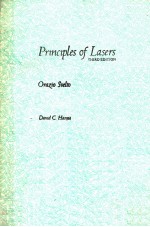

PRINCIPLES OF LASERS THIRD EDITIONPDF电子书下载
- 电子书积分:15 积分如何计算积分?
- 作 者:ORAZIO SVELTO DAVID C.HANNA
- 出 版 社:PLENUM PRESS
- 出版年份:2222
- ISBN:0306429675
- 页数:494 页
1.Introductory Concepts 1
1.1.Spontaneous and Stimulated Emission, Absorption 1
1.1.1.Spontaneous Emission 1
1.1.2.Stimulated Emission 2
1.1.3.Absorption 3
1.2.The Laser-Idea 4
1.3.Pumping Schemes 6
1.4.Properties of Laser Beams 8
1.4.1.Monochromaticity 8
1.4.2.Coherence 8
1.4.3.Directionality 10
1.4.4.Brightness 11
1.4.5.Short Time Duration 12
1.5.Organization of the Book 12
Problems 13
2.Interaction of Radiation with Matter 15
2.1.Introduction 15
2.2.Summary of Blackbody Radiation Theory 15
2.3.Absorption and Stimulated Emission 24
2.3.1.Rates of Absorption and Stimulated Emission 24
2.3.2.Allowed and Forbidden Transitions 28
2.3.3.Line-Broadening Mechanisms 30
2.3.3.1.Homogeneous Broadening 30
2.3.3.2.Inhomogeneous Broadening 36
2.3.3.3.Concluding Remarks and Examples 40
2.3.4.Transition Cross Section, Absorption, and Gain Coefficient 42
2.4.Spontaneous Emission 44
2.4.1.Semiclassical Approach 44
2.4.2.Quantum Electrodynamic Approach 47
2.4.3.Einstein Thermodynamic Treatment 49
2.4.4.Relation between Spontaneous Lifetime and Cross Section 52
2.4.5.Concluding Remarks 52
2.5.Nonradiative Decay 53
2.6.Saturation 57
2.6.1.Saturation of Absorption: Homogeneous line 58
2.6.2.Gain Saturation: Homogeneous Line 62
2.6.3.Inhomogeneously Broadened Line 65
2.7.Decay of a Many-Atom System 66
2.7.1.Radiation Trapping 66
2.7.2.Superradiance and Superfluorescence 66
2.7.3.Amplified Spontaneous Emission 68
2.8.Degenerate Levels 70
2.9.Molecular Systems 73
2.9.1.Energy Levels of a Molecule 73
2.9.2.Level Occapation at Thermal Equilibrium 78
2.9.3.Radiative and Nonradiative Transitions 79
2.9.4.Quantum Mechanical Calculation of the Radiative Transition Rates 82
Problems 85
References 88
3.Pumping Processes 91
3.1.introduction 91
3.2.Optical Pumping 92
3.2.1.Pumping Eflciency 96
3.2.2.Radiative and Transfer Efficiencies 97
3.2.3.Pump Light Distribution 103
3.2.4.Absorption and Power Quantum Eficiencies 108
3.2.5.Concluding Remarks 110
3.3.Electrical Pumping 111
3.3.1.Physical Characteristics of Discharges 113
3.3.2.Electron Impact Excitation 116
3.3.2.1.Electron Impact Cross Section 117
3.3.2.2.Electron Energy Distribution 120
3.3.2.3.Spatial Distribution of the Pump Rate 124
3.3.2.4.The Ionization Balance Equation 126
3.3.2.5.Pump Rate Calculation 127
3.3.3.Excitation by (Near) Resonant Energy Transfer 129
Problems 132
References 134
4.Passive Optical Resonators 137
4.1.Introduction 137
4.2.Some Topics from Geometrical and Wave Optics 141
4.2.1.Matrix Formulation of Geometrical Optics 142
4.2.2.The Fabry-Perot Interferometer 148
4.2.3.Multilayer-Dielectric Coatings 155
4.3.Photon Lifetime and Cavity Q 159
4.4.Plane-Parallel Resonator 161
4.4.1.Approximate Treatment 161
4.4.2.Fox and Li Treatment 163
4.5.Confocal Resonator 170
4.6.Gaussian Beam Propagation and the ABCD Law 179
4.7.Generalized Spherical Resonator 184
4.7.1.Mode Amplitudes 184
4.7.2.Resonance Frequencies and Diflraction Losses 186
4.7.3.Stability Condition 188
4.8.Unstable Resonators 192
4.8.1.Geometrical-Optics Description 193
4.8.2.Wave-Optics Description 197
4.8.3.Advantages and Disadvantages of Hard-Edge Unstable Resonates 199
4.8.4.Variable-Reflectivity Unstable Resonators 200
Problems 202
References 206
5.Continuous Wave and Transient Laser Behavior 207
5.1. Introduction 207
5.2.Rate Equations 207
5.2.1.Four-Level Laser 207
5.2.2.Three-Level Laser 210
5.3.CW Laser Behavior 217
5.3.1.Four-Level Laser 217
5.3.2.Three-Level Laser 219
5.3.3.Optimum Output Coupling 220
5.3.4.Laser Tuning 221
5.3.5.Single-Mode Versus Multimode Oscillation 223
5.3.5.1.Reasons for Multimode Oseillation 223
5.3.5.2.Single-Mode Oscillation 225
5.3.6.Two Numerical Examples 232
5.3.7.Frequency Pulling and Limit to Monochromaticity 238
5.3.8.Lamb Dip and Active Stabilization of Laser Frequency 240
5.4.Transient Laser Behavior 243
5.4.1.Relaxation Oscillations in Single-Mode Lasers 244
5.4.2.Spiking Behavior of Multimode Lasers 248
5.4.3.Q Switching 248
5.4.3.1.Methods of Q Switching 250
5.4.3.2.Operating Regimes 256
5.4.3.3.Theory of Active Q Switching 258
5.4.3.4.A Numerical Example 263
5.4.4.Gain Switching 265
5.4.5.Mode Locking 266
5.4.5.1.Methods of Mode Locking 272
5.4.5.2.Mode-Locking Systems 278
5.4.6.Cavity Dumping 281
5.5.Concluding Remarks 283
Problems 284
References 285
6.Types of Lasers 287
6.1.Introduction 287
6.2.Solid-State Lasers 287
6.2.1.The Ruby Laser 288
6.2.2.Neodymium Lasers 290
6.2.2.1.Nd:YAG 290
6.2.2.2.Nd:Glass 292
6.2.2.3.Other Crystalline Hosts 293
6.2.3.Alexandrite Laser 294
6.3.Gas Lasers 296
6.3.1.Neutral Atom Lasers 297
6.3.1.1.Helium-Neon Lasers 298
6.3.1.2.Copper and Gold Vapor Lasers 302
6.3.2.Ion Lasers 304
6.3.2.1.Argon Laser 305
6.3.2.2.He-Cd Laser 308
6.3.3.Molecular Gas Lasers 309
6.3.3.1.The CO2 Laser 310
6.3.3.2.The CO Laser 323
6.3.3.3.The N2 laser 325
6.3.3.4.Excimer Lasers 327
6.4.Liquid Lasers (Dye Lasers) 331
6.4.1.Photophysical Properties of Organic Dyes 331
6.4.2.Characteristics of Dye Lasers 335
6.5.Chemical Lasers 339
6.5.1.The HF Laser 340
6.6.Semiconductor Lasers 342
6.6.1.Photophysical Properties of Semiconductor Lasers 343
6.6.1.1.Energy States in a Semiconductor 344
6.6.1.2.Level Occupation at Thermal Equilibrium 346
6.6.1.3.Radiative and Nonradiative Transitions 347
6.6.1.4.The Quasi-Fermi Levels 348
6.6.2.Semiconductor-Laser Pumping 350
6.6.2.1.The Homojunction Laser 350
6.6.2.2.The Double-Heterojunction Laser 352
6.6.3.Semiconductor Laser Devices and Their Performance 354
6.6.4.Semiconductor Laser Applications 358
6.6.5.Simplified Theory of a Semiconductor Laser 359
6.7.Color-Center Lasers 363
6.8.The Free-Electron Laser 366
6.9.X-Ray Lasers 370
6.10.Summary of Performace Data 372
Problems 374
References 376
7.Properties of Laser Beams 379
7.1.Introduction 379
7.2.Monochromaticity 379
7.3.Complex Representation of Polychromatic Fields 380
7.4.Statistical Properties of Laser Light and Thermal Light 381
7.5.First-Order Coherence 383
7.5.1.Degree of Spatial and Temporal Coherence 384
7.5.2.Measurement of Spatial and Temporal Coherence 387
7.5.3.Relation Between Temporal Coherence and Monochromaticity 390
7.5.4.Nonstationary Beams 391
7.5.5.Spatial and Temporal Coherence of Single-Mode and Multimode Lasers 392
7.6.Directionality 394
7.6.1.Beams with Perfect Spatial Coherence 394
7.6.2.Beams with Partial Spatial Coherence 397
7.7.Laser Speckle 400
7.8.Brightness 404
7.9.Comparison Between Laser Light and Thermal Light 405
7.10.Higher-Order Coherence 406
Problems 408
References 410
8.Laser Beam Transformation: Propagation, Amplification, Frequency Conversion, Pulse Compression 411
8.1.Introduction 411
8.2.Transformation in Space: Gaussian Beam Propagation 412
8.3.Transformation in Amplitude: Laser Amplification 418
8.4.Frequency Conversion: Second-Harmonic Generation and Parametric Oscillation 424
8.4.1.Physical Picture 425
8.4.1.1.Second-Harmonic Generation 425
8.4.1.2.Parametric Oscillation 432
8.4.2.Analytical Treatment 435
8.4.2.1.Parametric Oscillation 437
8.4.2.2.Second-Harmonic Generation 441
8.5.Transformation in Time: Pulse Compression 444
Problems 453
References 454
Appendixes 459
A Semiclassical Treatment of the Interaction of Radiation with Matter 459
B Space-Dependent Rate Equations 465
C Theory of Active Mode Locking for a Homogeneous Line 471
D Physical Constants 477
Answers to Selected Problems 479
Index 487
- 《地球简史》(英)戴维·贝克(David Baker) 2020
- 《第三帝国的兴亡》(英)克里斯·毕晓普(Chris Bishop),(英)戴维·乔丹(David Jordan)著 2019
- 《图解轻武器史 剑、矛和锤》(美)大卫·苏德(David Soud)著;刘恒沙译 2017
- 《现代环境主义导论》(英)戴维·佩珀(David Pepper)著 2020
- 《中国经学史》(美)韩大伟(David B. Honey)著 2019
- 《火星生命 前往须知》(美)戴维·温特劳布(DAVID A. WEINTRAUB)著;傅承启译 2019
- 《程序员修炼之道 通向务实的最高境界 第2版》(美)David Thomas(大卫·托马斯),Andrew Hunt(安德鲁·亨特) 2020
- 《谁捉住了上帝粒子?》(法)大卫·卢阿普尔(David Louapre)著 2020
- 《博士生教育的变迁》(澳)大卫·鲍德(David Boud),(澳)艾莉森·李(Alison Lee)编 2019
- 《信息系统安全基础 原书第2版》(美)David Kim 2020
- 《竞争战略 全译珍藏版》(美)迈克尔·波特(Michael E. Porter)著 2012
- 《网络互联技术手册 第2版》(美)(K.唐斯)Kevin Downes等著;包晓露等译 1999
- 《新版交换式以太网和快速型以太网 第2版》(美)(R.布雷耶)Robert Breyer,(美)(S.赖利)Sean Riley著;肖文贵等译 1997
- 《摄影100关键词》(英)克拉克著 2011
- 《守望百年 中英文对照爱情长诗》蔡丽双著;张智中译 2014
- 《环境政策概要》(英)卡罗琳·斯奈尔(Carolyn Snell)著;宋伟译 2017
- 《驼铃 中-英-波兰文对照诗集》蔡丽双著;张智中,(波兰)博古米娜·雅尼卡译 2015
- 《爱海情帆 中-英-罗马尼亚文对照爱情长诗》蔡丽双著;张智中,德拉戈斯·巴尔布译 2016
- 《准备,开始,哎哟》(美)弗兰·马努斯肯著;(美)黛安娜·帕尔米西若绘;魏亚西译 2014
- 《埋藏在后院》(美)盖尔·赫尔曼著;(美)杰里·斯马斯绘;筱舟译 2014
